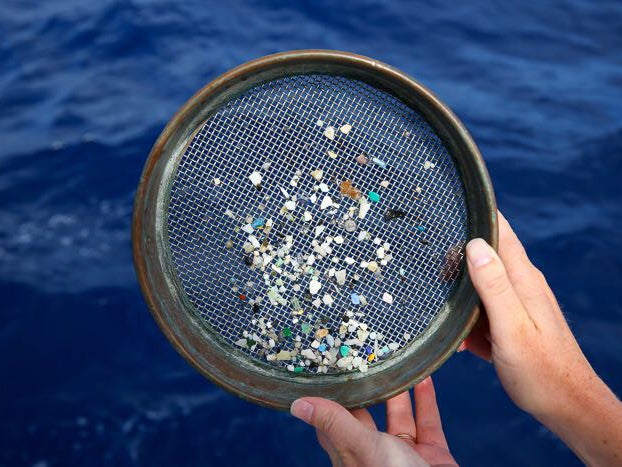Plastic pollution: Skipper describes horror at seeing ‘endless’ ocean of rubbish on Pacific research expedition
Exclusive: ‘How do you convey – when you wake up on day four and you’re still seeing this plastic pouring past the boat? The feeling just makes your stomach clench’
An experienced skipper who is currently sailing through the world’s largest ocean rubbish patch has described how her stomach “clenched” when she was faced with the terrible reality of the planet’s plastic crisis.
Emily Penn is leading an all-women expedition through the Pacific Ocean on a mission to tackle the plastic pollution that is choking marine environments, killing animals and even threatening human health.
“The most alarming thing is just the number of pieces that are moving past the boat every time you look out,” says Ms Penn, a sailor with a history of environmental activism.
“You might get a bundle of fishing net, a washing basket, a chair; then you see bottle tops, toothbrushes, combs – people’s belongings basically. It doesn’t make any sense.”
Just as appalling, she says, are the endless tiny shards of plastic that fill the apparently empty spaces between the larger objects. These “microplastics” have been found in the stomachs of fish and shellfish around the world.
“That’s what we have been experiencing on a daily basis for the past 500 miles or so,” she says.

At least 8 million tonnes of plastic is dumped in the ocean every year, and a large proportion ultimately ends up in one of the five major ocean gyres; drawn in by winds and ocean currents.
The largest of these gyres, dubbed the “Great Pacific Garbage Patch”, covers an area of 1.6 million square kilometres.
It is this enormous expanse that Ms Penn and her “eXXpedition” crew of scientists, sailors and artists is crossing on a trip that will take them from the plastic-strewn beaches of Hawaii to the shores of North America – the source of so much of this waste.
Speaking to The Independent via satellite phone from the Sea Dragon, a 72ft (22m) scientific exploration vessel, Ms Penn described the low mood that set in as they entered the plastic soup.
“How do you convey – when you wake up on day four and you’re still seeing this plastic pouring past the boat. The feeling just makes your stomach clench,” she says.
The team is collecting samples and data that will then be sent to research institutions in the UK, Canada, Switzerland and the US.

This information is valuable, because owing to their remote locations there is still a lot scientists do not know about the Great Pacific Garbage Patch and other plastic accumulation zones.
Horrific images of turtles tangled in fishing nets and whales with stomachs full of bags have shocked the world, but the eXXpedition crew wants to investigate the subtler effects of plastic pollution.
Their samples will be examined for traces of chemicals like pesticides and flame retardants that have the potential to leach into the bodies of animals and – ultimately – humans.

Being out in the open ocean has made the crew acutely aware of the interactions between wild animals and plastic waste.
“We are looking into the water and seeing fragments of plastic, and then 20m away we see an albatross feeding on squid which looks just like that plastic,” says Ms Penn.
The key to solving this problem, she says, is first to raise awareness and then to cut off the flow of plastic before it enters the ocean.
“There are trillions of fragments covering this part of the planet and it’s just endless, it goes on and on, and not only here in the North Pacific but other parts of the world as well,” says Ms Penn.
“It’s taken us weeks to get here under challenging conditions, and the idea then of trying to extract the little fragments you just realise – gosh – we have to solve this problem at the source. By the time it’s out here it’s too late.”
Join our commenting forum
Join thought-provoking conversations, follow other Independent readers and see their replies
Comments
Bookmark popover
Removed from bookmarks